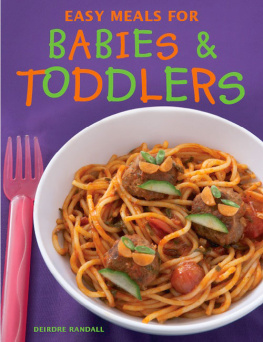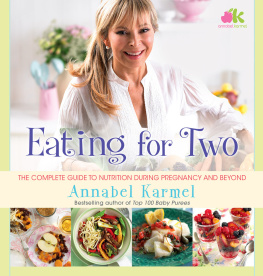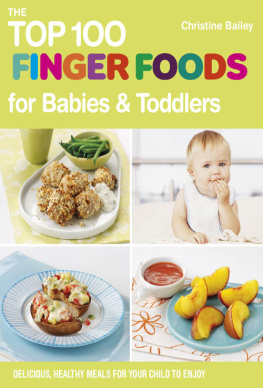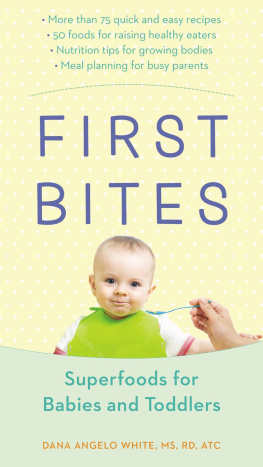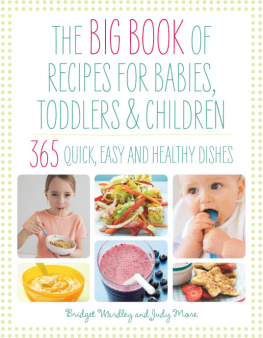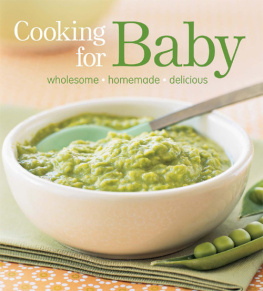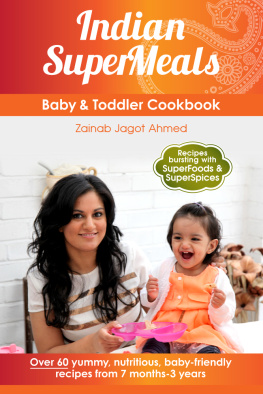EASY MEALS FOR
B A B I E S &
T O D D L E R S

This book is dedicated to my parents:
Keith and Doreen Alexander
With all my love
DEIRDRE RANDALL
CONTENTS
INTRODUCTION
Food is one of the greatest sensory delights of our lives. From the very first tip of a teaspoon of solid food that a baby experiences, we are in a position to influence a positive, joyous lifelong relationship with food which will also ensure that nutritional needs are met.
When the toddler stage begins, because of the added psychological factors, the food scenario becomes all the more complex.
Food is more than simply a means of sustaining life. It is an integral part of our social interaction, and much depends on the presentation of the food and the attitude with which it is served. Just as adults enjoy food that is appetising in terms of its taste, aroma, colour and texture (which Ive termed TACT), it is even more important to consider these important aspects of food when preparing meals which will stimulate your baby or your toddler to eat.
By taking these factors into consideration when preparing meals for babies and toddlers, we can make eating fun and part of the learning process a baby experiences from birth. This will do much towards inculcating a positive attitude towards food and healthy eating patterns for life.
For the purpose of convenience, I use the term baby when referring to children under one year of age and the term toddler when referring to a child between the ages of one and two.
This book begins with the introduction of solids, which babies usually start eating at the age of about four months, and then deals mainly with the challenging transitional toddler period (about one to two years old) between the baby food stage and the child being able to eat conventional food.
Because of the rate at which tactile, spatial and perceptual development takes place at the toddler stage, it is essential that meals be interesting and encompass the sensory qualities of taste, aroma, colour and texture (TACT).
Cooking for babies and toddlers is exciting, creative and rewarding have fun!
THE DAILY NUTRITIONAL REQUIREMENTS
About 70% of a babys brain has developed by the age of 12 months. During this time she will generally triple her birth-weight and increase in length by 50%. This incredibly rapid growth is never equalled later in life. Therefore it is essential that babies and toddlers are stimulated by using all their senses when experiencing food. Food is an integral part of a baby or toddlers life. It is consistently offered every day and if it is interesting and nutritious, there is no doubt that this will have lifelong advantages. Babies and toddlers respond to bold contrasts, faces and designs. They have an excellent sense of smell as well as highly attuned sensory abilities, so touching food and feeling it in their mouths, whilst experiencing a myriad of different flavours, colours and aromas, will develop their tactile skills. Pleasant conversation and, sometimes, a sense of adventure and fun, will contribute towards a positive association with food. All of this has been taken into consideration in the preparation of the meals in this book.
Breast milk or formula is the most important food in any babys life until the age of nine months, and during her first four months she will be fed almost entirely on it. Whether to breastfeed or not is a personal choice, and there are organisations that will assist you whatever you decide (see ). Every baby is different and their food needs also differ, but a general guideline as to how much milk a baby should be getting every 24 hours is 150 ml per kilogram of the babys weight.
For instance, a baby weighing 5 kg should be drinking about 750 ml of milk a day. Between the ages of four and six months a babys milk intake rises gradually to approximately 1 litre every 24 hours. This is also the stage where the introduction to solids slowly begins. From six months onwards, milk alone is not sufficient for the babys nutritional needs (particularly for iron). Daily milk intake decreases gradually to about 600 ml, and this is supplemented by solids and other fluids. By the time a baby is nine months old, she should be having three small meals (encompassing relevant foods from the food groups discussed below) as well as approximately 600 ml of milk each day. Water and other fluids are also essential. This is where the all-important issues of TACT (taste, aroma, colour and texture) are so vital. Think of how bright and colourful we make our babies rooms, with interesting curtains, toys, covers, cot bumpers and mobiles. Food is one of the most important components of a babys life and it should be just as interesting to stimulate and motivate the child to eat.
You can continue breastfeeding for as long as you and your baby find it convenient and enjoyable, but should you decide to change from formula or breast milk to cows milk, this should only be introduced from the age of 12 months. Only full-cream milk should be given to a baby not skim or low-fat milk. Once babies are on full-cream milk you may consider partial replacement of milk with other dairy products, for instance 1 cup of natural yoghurt which is the equivalent of 1 cup of milk or 30 g of grated cheddar or mozzarella cheese. If you introduce milk products such as cheese or yoghurt before your baby has begun to drink cows milk, ensure that you do so over a three-day period so that you will be well aware of it if she has an intolerance to lactose (see ).
PROTEIN
As well as being an excellent source of energy, protein is essential for the growth and repair of cells, for the manufacture of hormones and enzymes, and for building up the antibodies which enable the body to resist and overcome disease. Complete protein (mostly animal protein) contains all the essential amino acids and is found in meat, fish, eggs, cheese, milk and soya beans. Incomplete protein (vegetable protein) does not contain all the essential amino acids and is found mainly in cereals, nuts, green vegetables, flour, bread, yeast and pulses. Nuts and pulses are super foods, in that they are highly nutritious. However, they should be ground before giving them to babies and toddlers, as they could cause choking. Some children are also allergic to nuts (which may last their entire lives), so rather introduce a very small quantity of ground nuts from 18 months over a three-day period and see whether your child has a reaction to them before including them in the diet (see ).
CARBOHYDRATES
Carbohydrates (sugars and starches) are essential for providing heat and energy. Starch carbohydrates are found in flour, bread, cereals and cereal products, pasta, rice, potatoes, pulses, bran, seeds and bread. Sucrose, the most common form of sugar in the diet, is found in sugar, fruit, vegetables, honey and jam.
WHAT IS THE GLYCAEMIC INDEX (GI)?
The glycaemic index (GI) is a ranking system for carbohydrates based on their effect on blood glucose levels in the body. Low GI foods break down slowly during digestion so the body releases insulin slowly. This makes one feel fuller for longer, which helps with weight control and also prevents energy dips that can occur a few hours after a meal. It is usually during these energy dips that active older toddlers may want something sweet, so it is advisable to include foods low in GI in your toddlers diet, especially at breakfast and at the evening meal.

